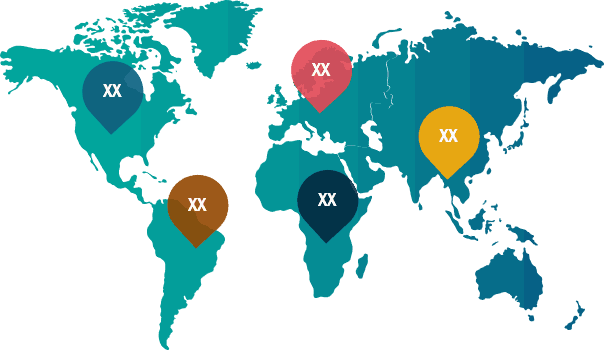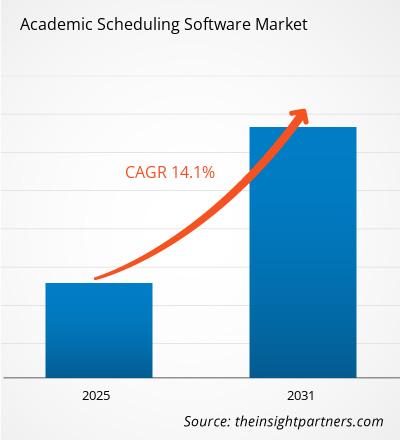学术排程软件市场预计在 2023-2031 年期间的复合年增长率为 14.1%。人工智能排程算法和个性化学生排程可能仍是市场的主要趋势。
学术排程软件市场分析
- 学术排程软件市场包括能够自动确保学校、学院、大学等教育机构的排程过程速度和效率的软件产品。
- 一些驱动因素包括对学术学习应用程序的需求不断增加、人工智能和机器学习等先进技术的实施增加以及互联网可访问性。
- 该软件广泛应用于学校、大学、学院等教育机构。学术软件市场的一些趋势是使用先进的技术和基于云的解决方案。
学术排程软件市场概览
- 学术安排软件通常由学院、大学和学校用于安排学术日历和日记,教职员工和学生可以借此计划每日、每周、每月、学期或全年的时间表。
- 由于先进数字化的激增,学术学习软件市场的数量将会增加。
- 学术排程软件进一步细分为五个地理区域,即拉丁美洲、北美、欧洲、亚太、中东和非洲。学术排程软件市场主要由北美地区主导,该地区在先进技术和数字化方面处于领先地位。
- 在学术安排软件中发挥重要作用的主要参与者包括应用软件顾问、CollegeNET、College scheduler、ASIMUT 软件 APS 和 FamilyID 等。
定制研究以满足您的需求
我们可以优化和定制标准产品无法满足的分析和范围。这种灵活性将帮助您获得业务规划和决策所需的准确信息。
学术排程软件市场:战略洞察

复合年增长率(2023 - 2031)14.1%- 2023 年市场规模
XX 百万美元 - 市场规模 2031
美元 XX 百万美元

市场动态
- 学术项目日益复杂,资源优化的需求
- 基于云的解决方案
- 人工智能调度算法,个性化学生时间表
关键人物
- 应用软件顾问
- ASIMUT 软件 ApS
- 大学日程安排
- 大学网
- 驾驶员教育解决方案
- EMS 软件
- 家庭编号
- 福雷迪安科技
- 蓝宝石软件
区域概况

- 北美
- 欧洲
- 亚太
- 南美洲和中美洲
- 中东和非洲
市场细分
 产品类型
产品类型- 基于云和基于网络
 终端用户行业
终端用户行业- 学校
- 学院
- 大学和教育机构
- 示例 PDF 通过定性和定量分析展示了内容结构和信息的性质。
学术排程软件市场驱动因素和机遇
学术项目日益复杂,有利于市场
- 如今的大学通常提供种类繁多的课程、专业和专业。这种多样性给课程安排带来了挑战,因为这些课程组合可能具有先决条件和依赖关系。
- 此外,课程中包括多个院系甚至不同学院的课程也已变得很常见。此类课程需要不同教师协调时间表。
- 许多课程可能包含讲座、研讨会、实验室、在线课程等,每个课程都有各自的时间安排需求。总体而言,课程依赖性和众多课程要求需要有计划的时间安排,以确保学生能够完成学业。
基于云的解决方案
- 由于它们是基于云的,用户可以从任何具有互联网连接的计算机或设备访问调度软件,这意味着管理员、教师和学生可以从远程位置查看和编辑调度软件。
- 通过云解决方案,机构可以根据不断增加的入学人数(即更多的学生)或不断增加的课程设置(即更多的班级)进行扩展,而不必进行大量的硬件投资来继续运行软件以满足不断增长的学生人数。
- 许多调度系统需要花费高昂的前期成本来获取计算硬件和软件许可证,而这些成本可以通过基于订阅的定价模式分摊。
学术排程软件市场报告细分分析
有助于得出学术调度软件市场分析的关键部分是类型和最终用户行业。
- 根据产品类型,学术排程软件市场分为基于云的和基于网络的。
- 根据最终用户行业,学术排程软件市场分为学校、学院、大学和教育机构。
学术排程软件市场份额按地区分析
- 学术排程软件市场报告包括对五个主要地理区域的详细分析,其中包括当前和历史市场规模以及 2021 年至 2031 年的预测,涵盖北美、欧洲、亚太地区 (APAC)、中东和非洲 (MEA) 以及南美洲和中美洲。
- 每个地区进一步细分为各个国家。本报告提供 18 个国家的分析和预测,涵盖学术排程软件市场动态,例如影响区域市场的驱动因素、趋势和机会。
- 此外,该报告还涵盖 PEST 分析,其中涉及影响这些地区学术调度软件市场的主要因素的研究。
学术排程软件市场报告范围
| 报告属性 | 细节 |
|---|---|
| 2023 年的市场规模 | XX 百万美元 |
| 2031 年市场规模 | XX 百万美元 |
| 全球复合年增长率(2023 - 2031) | 14.1% |
| 史料 | 2021-2022 |
| 预测期 | 2024-2031 |
| 涵盖的领域 | 按产品类型
|
| 覆盖地区和国家 | 北美
|
| 市场领导者和主要公司简介 |
|
- 示例 PDF 通过定性和定量分析展示了内容结构和信息的性质。
学术排程软件市场新闻和最新发展
学术排程软件市场通过收集主要和次要研究后的定性和定量数据进行评估,其中包括重要的公司出版物、协会数据和数据库。学术排程软件市场的一些发展如下:
- CollegeNET, Inc. 今天宣布,其 25Live 房间和活动调度系统现已与 CourseLeaf 的 Section Scheduler (CLSS) 集成。这扩大了两家公司之间的合作伙伴关系,以提高其高等教育客户的调度能力。(来源:CollegeNET, Inc.,新闻稿,2021 年 1 月)
学术调度软件市场报告范围和交付成果
“学术调度软件市场规模和预测(2021-2031)”报告对市场进行了详细的分析,涵盖以下领域:
- 学术排程软件市场规模及预测,涵盖全球、地区和国家层面的所有关键细分市场
- 学术排程软件市场趋势以及市场动态,如驱动因素、限制因素和关键机遇
- 详细的 PEST/波特五力分析和 SWOT 分析
- 学术调度软件市场分析涵盖关键市场趋势、全球和、主要参与者、法规和最新市场发展
- 行业格局和竞争分析,涵盖市场集中度、热图分析、知名参与者以及学术调度软件市场的最新发展
- 详细的公司简介
- 历史分析(2 年)、基准年、预测(7 年)及复合年增长率
- PEST 和 SWOT 分析
- 市场规模价值/数量 - 全球、区域、国家
- 行业和竞争格局
- Excel 数据集


- Personality Assessment Solution Market
- Extracellular Matrix Market
- Workwear Market
- Investor ESG Software Market
- Military Rubber Tracks Market
- Micro-Surgical Robot Market
- Skin Graft Market
- Integrated Platform Management System Market
- Advanced Planning and Scheduling Software Market
- Airline Ancillary Services Market

Report Coverage
Revenue forecast, Company Analysis, Industry landscape, Growth factors, and Trends

Segment Covered
This text is related
to segments covered.

Regional Scope
North America, Europe, Asia Pacific, Middle East & Africa, South & Central America

Country Scope
This text is related
to country scope.
常见问题
Some of the customization options available based on request are additional 3–5 company profiles and country-specific analysis of 3–5 countries of your choice. Customizations are to be requested/discussed before making final order confirmation, as our team would review the same and check the feasibility.
The report can be delivered in PDF/PPT format; we can also share excel dataset based on the request.
The leading players operating in the Academic Scheduling Software market are Applied Software Consultants, ASIMUT software ApS, College Scheduler, CollegeNET, Drivers Ed Solutions, EMS Software, FamilyID, Foradian Technologies, and Sapphire Software.
AI-powered scheduling algorithms and personalized student schedules are likely to remain key trends in the market.
The global Academic Scheduling Software market is expected to grow at a CAGR of 14.1% during the forecast period 2023 - 2031.
The increasing complexity of academic programs and the need for resource optimization are expected to drive the academic scheduling software market.
Trends and growth analysis reports related to Technology, Media and Telecommunications : READ MORE..
The List of Companies
1. Applied Software Consultants
2. ASIMUT software ApS
3. College Scheduler
4. CollegeNET
5. Drivers Ed Solutions
6. EMS Software
7. FamilyID
8. Foradian Technologies
9. Sapphire Software
10. Schilling Consulting
11. Scholastico.com
The Insight Partners performs research in 4 major stages: Data Collection & Secondary Research, Primary Research, Data Analysis and Data Triangulation & Final Review.
- Data Collection and Secondary Research:
As a market research and consulting firm operating from a decade, we have published and advised several client across the globe. First step for any study will start with an assessment of currently available data and insights from existing reports. Further, historical and current market information is collected from Investor Presentations, Annual Reports, SEC Filings, etc., and other information related to company’s performance and market positioning are gathered from Paid Databases (Factiva, Hoovers, and Reuters) and various other publications available in public domain.
Several associations trade associates, technical forums, institutes, societies and organization are accessed to gain technical as well as market related insights through their publications such as research papers, blogs and press releases related to the studies are referred to get cues about the market. Further, white papers, journals, magazines, and other news articles published in last 3 years are scrutinized and analyzed to understand the current market trends.
- Primary Research:
The primarily interview analysis comprise of data obtained from industry participants interview and answers to survey questions gathered by in-house primary team.
For primary research, interviews are conducted with industry experts/CEOs/Marketing Managers/VPs/Subject Matter Experts from both demand and supply side to get a 360-degree view of the market. The primary team conducts several interviews based on the complexity of the markets to understand the various market trends and dynamics which makes research more credible and precise.
A typical research interview fulfils the following functions:
- Provides first-hand information on the market size, market trends, growth trends, competitive landscape, and outlook
- Validates and strengthens in-house secondary research findings
- Develops the analysis team’s expertise and market understanding
Primary research involves email interactions and telephone interviews for each market, category, segment, and sub-segment across geographies. The participants who typically take part in such a process include, but are not limited to:
- Industry participants: VPs, business development managers, market intelligence managers and national sales managers
- Outside experts: Valuation experts, research analysts and key opinion leaders specializing in the electronics and semiconductor industry.
Below is the breakup of our primary respondents by company, designation, and region:

Once we receive the confirmation from primary research sources or primary respondents, we finalize the base year market estimation and forecast the data as per the macroeconomic and microeconomic factors assessed during data collection.
- Data Analysis:
Once data is validated through both secondary as well as primary respondents, we finalize the market estimations by hypothesis formulation and factor analysis at regional and country level.
- Macro-Economic Factor Analysis:
We analyse macroeconomic indicators such the gross domestic product (GDP), increase in the demand for goods and services across industries, technological advancement, regional economic growth, governmental policies, the influence of COVID-19, PEST analysis, and other aspects. This analysis aids in setting benchmarks for various nations/regions and approximating market splits. Additionally, the general trend of the aforementioned components aid in determining the market's development possibilities.
- Country Level Data:
Various factors that are especially aligned to the country are taken into account to determine the market size for a certain area and country, including the presence of vendors, such as headquarters and offices, the country's GDP, demand patterns, and industry growth. To comprehend the market dynamics for the nation, a number of growth variables, inhibitors, application areas, and current market trends are researched. The aforementioned elements aid in determining the country's overall market's growth potential.
- Company Profile:
The “Table of Contents” is formulated by listing and analyzing more than 25 - 30 companies operating in the market ecosystem across geographies. However, we profile only 10 companies as a standard practice in our syndicate reports. These 10 companies comprise leading, emerging, and regional players. Nonetheless, our analysis is not restricted to the 10 listed companies, we also analyze other companies present in the market to develop a holistic view and understand the prevailing trends. The “Company Profiles” section in the report covers key facts, business description, products & services, financial information, SWOT analysis, and key developments. The financial information presented is extracted from the annual reports and official documents of the publicly listed companies. Upon collecting the information for the sections of respective companies, we verify them via various primary sources and then compile the data in respective company profiles. The company level information helps us in deriving the base number as well as in forecasting the market size.
- Developing Base Number:
Aggregation of sales statistics (2020-2022) and macro-economic factor, and other secondary and primary research insights are utilized to arrive at base number and related market shares for 2022. The data gaps are identified in this step and relevant market data is analyzed, collected from paid primary interviews or databases. On finalizing the base year market size, forecasts are developed on the basis of macro-economic, industry and market growth factors and company level analysis.
- Data Triangulation and Final Review:
The market findings and base year market size calculations are validated from supply as well as demand side. Demand side validations are based on macro-economic factor analysis and benchmarks for respective regions and countries. In case of supply side validations, revenues of major companies are estimated (in case not available) based on industry benchmark, approximate number of employees, product portfolio, and primary interviews revenues are gathered. Further revenue from target product/service segment is assessed to avoid overshooting of market statistics. In case of heavy deviations between supply and demand side values, all thes steps are repeated to achieve synchronization.
We follow an iterative model, wherein we share our research findings with Subject Matter Experts (SME’s) and Key Opinion Leaders (KOLs) until consensus view of the market is not formulated – this model negates any drastic deviation in the opinions of experts. Only validated and universally acceptable research findings are quoted in our reports.
We have important check points that we use to validate our research findings – which we call – data triangulation, where we validate the information, we generate from secondary sources with primary interviews and then we re-validate with our internal data bases and Subject matter experts. This comprehensive model enables us to deliver high quality, reliable data in shortest possible time.

 获取此报告的免费样本
获取此报告的免费样本